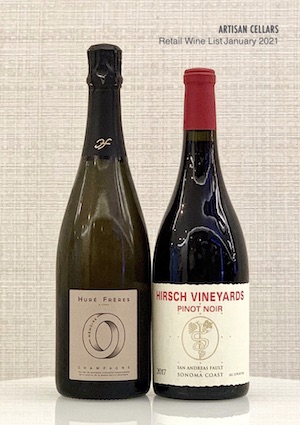| Superstar Julien
Guillot is making some of the most sought-after
wines in Burgundy, and his stupendous 2019s will
simply perpetuate his legend. Limited magnums and
very rare Fine and Marc de Bourgogne brandies are
here too. Allocation rules will apply. |
|
| View online | |
| Clos des Vignes du Maynes |
| Julien Guillot |
| A bona fide star
talent. A showstopping vintage. Simply glorious
wines. |
 |
| This is an iconic
estate in the Mâconnais, and readers shouldn’t
hesitate to experience these singular wines for
themselves. — William Kelley Rebel, Artist, Philosopher, responsible and committed Winemaker, Julien Guillot is a complex character. But, after meeting him, the concept of natural wine has never appeared so clear and precise. — Guillaume Laroche, “Between The Vines” |
|
| Ancient. Quaint. Unsullied. One visit to Clos des Vignes du Maynes is all it takes to be in the presence of over a thousand years of viticultural history. |
The “Clos” itself is an enclosed vineyard that has been
continuously planted with vines for 1100 years. There are
no parcels like it: the vineyard has never had any
chemicals used on it since the 10th century, nor has the
vineyard ever been planted with any modern clone of any
grape. Remnants of an old Roman wall stand on the
property, witness to eleven centuries of winemaking
heritage dating back to the powerful medieval monks of
Cluny.
Julien Guillot is the present-day steward of this
land, worked by his family since 1954. Even back then,
Julien’s grandfather Pierre was always adamant about
making wine organically, using no chemicals, herbicides,
pesticides or sulphur – resisting the post-war
industrialization wave that was sweeping through the
agricultural heartlands. When Julien’s father, Alain,
later took over the domaine, he stood by the same
philosophy. Julien himself joined the domaine in 1998,
which is when he took the farming practices one step
further and introduced the first biodynamic preparations,
eventually converting the entire vineyard. (It has been
Demeter-certified since 2005.)
As far as history goes, Clos des Vignes du Maynes has
remained pristine, reliant only on mother nature’s good
graces and an ancient savoir faire passed down
through generations of steadfast vineyard stewards. Julien
is fortunate in that he has never had to undo what his
predecessors had done to the land.
The 6-hectare clos is set in idyllic
surroundings, blessed with unique geographical features
that impart great complexity and unusual minerality to the
wines. This special terroir comprises three parcels
planted with three indigenous grape varieties: Pinot Noir,
Gamay and Chardonnay, in roughly equal proportion. During
the harvest, grapes are carefully handpicked and sorted
meticulously in the vineyard, and then placed in small
containers, in order not to damage them during their
journey to the winery.

In the cellar, Julien uses natural yeasts, no sulphur, no
enzymes and no chemical additives. The wooden vats are
cleaned thoroughly beforehand, and they are scrubbed with
marc de Bourgogne to stimulate the yeasts.
For the red wines, he carries out a semi-carbonic
maceration, using a very precise method that has been
perfected over three generations. The basic principle is
to create a multi-layered ‘cake’ built up of alternate
layers of whole clusters and destemmed grapes. The latter
will produce the first juice, which will flow out, start
fermenting, and thus activate the natural yeasts (with the
sugars), which gives the body and smoothness that he is
looking for in his wines. At the same time, because the
vat is saturated with CO2, an intracellular fermentation
takes place, which brings out the elegant floral aromas
(rose and peony) that are typical of pinot noir. Then,
after four or five days, he does a very light pumping over
as well as a punching down of the cap. This is done in
order to release the sugars and yeasts, and thus trigger a
long and gentle fermentation.
All of the red wines are then matured in barrels or old
oak vats, and left undisturbed until Easter, when they are
assembled in one vat per cuvée and left to rest for two
full moons. The white wines are matured in large vats in
order to maintain their freshness and CO2 levels, and to
avoid having any oaky overtones, which he finds
undesirable in his wines. Unless absolutely necessary, he
does not add any SO2 before bottling, nor are the wines
fined or filtered. Wines from outside the Clos in Cruzille
are from small parcels in the Mâcon and Beaujolais, and
are vinified with the same techniques as those from the
Clos.
| And he’s a
darling of the so-called natural wine movement, his
wines coveted by Parisian cavistes and East
Coast sommeliers alike. They merit all the
attention, because Guillot is far from a follower of
fashion… — William Kelley What Clos des Vignes du Maynes’ appellations lack in grandeur is made up for in the domaine’s unimpeachable history and winemaking acumen. The vineyards have never been treated with pesticides or herbicides, and have always been replanted using selection massale. — Aaron Ayscough, Not Drinking Poison in Paris |
|
Julien is a dynamic
wine thinker, someone who never stops observing and
learning. His sole mission: terroir expression.
“I think that the feeling you get in your mouth is very
important: the texture of the wine, its silkiness or
velvety touch [ … ] I am looking for finishes that reflect
the wine’s terroir as authentically as possible. It is
essential for the geology to come out in each wine, be it
granite, limestone or white clay. The grape variety is
actually less important because it simply acts as a vector
for the terroir.”
He is an enthusiastic student of history — a fitting
passion for the guardian of such a singular vineyard. For
his iconic Cuvée 910,
in 2009 and 2010, he even reenacted a medieval harvest and
the transportation of the barrels by traditional oxcart to
Cluny Abbey nine months later. But as Julien notes, in
those times, wines had an alcohol level of only 8%, an
observation which has led him to become especially
invested in the topic of climate change.
All the hype you’ve heard (and will read in the coming
weeks as well-known wine publications release their
reports) about vintage 2019 is true, and at Clos des Vignes du Maynes, Julien
has delivered what we believe to be the domaine’s finest
moment yet. The gift of the vintage is its delivery of
unbridled ripeness with outstanding energy. In the best
examples, you’ll experience perfect sweetness of fruit
that doesn’t weigh down the palate, and which reverberates
with ethereal inner-mouth perfume. And this is what you’ll
encounter in the 2019 releases from Domaine des Vignes du
Maynes.
 We’re super excited to be one of the first few places on the planet to receive the full set of the domaine’s famous red cuvées, which we are thrilled to offer to you today. Beyond this, we’ve also included a limited number of magnums as well as a special library release of the Marc and Fine de Bourgogne from the early 2000s. The latter are exceptional Burgundian brandies that were produced in minuscule quantities of less than 140 bottles each, so we’re not kidding when we say they’re incredibly rare. |
The line-up at Clos des Vignes du Maynes offers a complex
gustatory exploration of this special property and its
uniquely preserved terroir. We were mind-blown when
tasting these 2019s; these beauties are greatness in the
making. Quantities are very limited, however, so
allocation rules will apply. As with any offers of
such a nature, balanced orders and Artisan Cellars’ most
supportive customers will receive priority.
This offer is valid until 25 January 2021. Orders will be processed subject to remaining availability and final written confirmation. Full payment is required no later than 7 days after confirmation invoice is sent in order to confirm the purchase. All terms and conditions apply.
| - OFFER VALID ONLY UNTIL
25 January 2021 - PRICES ARE QUOTED NETT in SGD - ALLOCATION RULES MAY APPLY - SUBJECT TO FINAL WRITTEN CONFIRMATIOn ** Photos may not represent actual Bottle / vintage ** |
| Red Wines |
| And the
reds are superb: satiny and perfumed expressions
of Pinot Noir and Gamay that disappear dangerously
rapidly. — William Kelley |
|
 |
|||||
|
 |
|||||
|
 |
||||||
|
| Eaux de Vie — Ultra-Limited Library
Release |
 |
|||||
|
 |
|||||
|
TERMS
& CONDITIONS
|
ARTISAN CELLARS JANUARY
2021 WINE LIST This list outlines a
compilation of artisanal wines that we carry. We
take pride in the sourcing and provenance of our
wines, from the most affordable to the higher ends.
As importers, most of our wines come direct from the
estates. We are proud to work with the most
respected growers from every wine region, each of
them representing the very best that their
respective appellation is capable of producing. To
augment our list, we occasionally include quality
wines from only impeccable sources. Regardless of
point of origin, we are always committed to shipping
and storing them in ideal cellar conditions. Please
email us at sales@artisan-cellars.com
or call us at +65 6838 0373 to enquire about exact
availability of wines, or to find out anything you
wish to know about our wines. This list outlines a
compilation of artisanal wines that we carry. We
take pride in the sourcing and provenance of our
wines, from the most affordable to the higher ends.
As importers, most of our wines come direct from the
estates. We are proud to work with the most
respected growers from every wine region, each of
them representing the very best that their
respective appellation is capable of producing. To
augment our list, we occasionally include quality
wines from only impeccable sources. Regardless of
point of origin, we are always committed to shipping
and storing them in ideal cellar conditions. Please
email us at sales@artisan-cellars.com
or call us at +65 6838 0373 to enquire about exact
availability of wines, or to find out anything you
wish to know about our wines. |
||||
|
390 Orchard Road B1-01 Palais Renaissance Singapore 238871 t +65 6838 0373 f +65 6836 0036 e sales@artisan-cellars.com w www.artisan-cellars.com |
 |